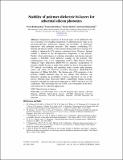Stability of polymer-dielectric bi-layers for athermal silicon photonics
Author(s)
Raghunathan, Vivek; Izuhara, Tomoyuki; Michel, Jurgen; Kimerling, Lionel C.
DownloadKimerling_Stability of polymer.pdf (1.022Mb)
PUBLISHER_POLICY
Publisher Policy
Article is made available in accordance with the publisher's policy and may be subject to US copyright law. Please refer to the publisher's site for terms of use.
Terms of use
Metadata
Show full item recordAbstract
Temperature sensitivity of Si based rings can be nullified by the use of polymer over-cladding. Integration of athermal passive rings in an electronic-photonic architecture requires the possibility of multi-layer depositions with patterned structures. This requires establishing UV, thermal and plasma stability of the polymer during multi-layer stacking. UV stability is enhanced by UV curing to saturation levels. However, thermal stability is limited by the decomposition temperature of the polymer. Further, robust performance in oxidizing atmosphere and plasma exposure requires a SiO[subscript 2]/SiN[subscript x] based dielectric coatings on the polymer. This communication uses a low temperature (130°C) High Density Plasma Chemical Vapor Deposition (HDPCVD) for dielectric encapsulation of polymer cladded Si rings to make them suitable for device layer deposition. UV induced cross-linking and annealing under vacuum make polymer robust and stable for Electron Cyclotron Resonance (ECR)-PECVD deposition of 500nm SiO[subscript 2]/SiN[subscript x]. The thermo-optic (TO) properties of the polymer cladded athermal rings do not change after dielectric cap deposition opening up possibilities of device deposition on top of the passive athermal rings. Back-end CMOS compatibility requires polymer materials with high decomposition temperature (> 400°C) that have low TO coefficients. This encourages the use of SiN[subscript x] core waveguides in the back-end architecture for athermal applications.
Date issued
2012-06Department
MIT Materials Research Laboratory; Massachusetts Institute of Technology. Department of Materials Science and Engineering; Massachusetts Institute of Technology. Microphotonics CenterJournal
Optics Express
Publisher
Optical Society of America
Citation
Raghunathan, Vivek et al. “Stability of Polymer-dielectric Bi-layers for Athermal Silicon Photonics.” Optics Express 20.14 (2012): 16059. © 2012 OSA
Version: Final published version
ISSN
1094-4087